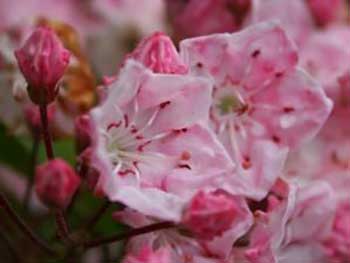Deadly gem rediscovered
For a long time we assumed that all the plants growing along the edge of the Old Arboretum - parallel to Main Drive near to the Great Oak Hall entrance to the Old Arboretum - were rhododendrons, but during recent clearance work we rediscovered a calico bush (Kalmia latifolia).

Today, it remains our only specimen of this species. Also known as Mountain-laurel it is native to the eastern United States and has attractive flowers ranging from light pink to white that are now in full bloom.
But beware; the plant is poisonous. Indeed it was once apparently used by native North American tribes to commit suicide. It is one of the plants (along with certain rhododendrons) responsible for ‘honey intoxication’, caused by the consumption of honey produced from the plant’s nectar. In severe cases there can be loss of coordination, slow pulse and difficulty breathing. Indeed the earliest record of rhododendron comes from Babylon in 401 B.C when the army of Xenophon were overcome after consuming honey made from Rhododendron luteum.
